The popularity of bettas comes as no surprise to the scores of betta fish enthusiasts out there. Koi betta fish, in particular, have captured the hearts of many people with their vibrant colors and patterns. These beautiful fish feature some of the brightest colors in the animal kingdom, making them a hit among fishkeepers.
If you’re thinking of getting a koi betta fish of your own, then you’ve come to the right place. In this ultimate care guide, we’ll teach you everything you need to know about caring for these immensely popular fish. Once you’re done reading this, you’ll be well on your way to becoming a koi betta fish expert!
Characteristics/Appearance/Lifespan
Common Name (species)
Koi Betta, Marbled Betta (Betta splendens)
Family
Osphronemidae
Origin
Southeast Asia
Diet
Omnivore
Care Level
Easy
Activity
Active, social, alert
Temperament
Aggressive
Tank Level
Top
Minimum Tank Size
5 Gallons
Temperature Range
72 – 80 degrees Fahrenheit
Water Hardness
5 – 20 dH
pH Range
6.5 – 7.5
Filtration/Flow Rate
Calm
Breeding
Egglayer
Compatibility
Similarly-sized community fish
OK, for Planted Tanks?
Yes, but check the roots constantly because decomposition can lead to fatal ammonia spikes
What Do Koi Betta Fish Look Like?
Koi betta, sometimes known as galaxy koi betta, is a variation of marble bettas that exhibit a unique and beautiful color pattern. As their name suggests, these fish are named after the Japanese koi fish due to their similar appearance – from the bright vivid colors that cover their bodies to the iridescent scaling.
Although the most common type of koi bettas is the short-tailed variation, long-finned koi bettas have become increasingly popular in recent years. These fish have similar color patterns to their short-finned counterparts but have much longer fins that flow gracefully behind them as they swim.
Tail type is not the only difference between koi bettas – these fish also come in a wide variety of colors and patterns. Blue patches, red streaks, and white spots are just some of the many different colorations you’ll find on these beautiful fish. No two koi bettas are exactly alike, making them a truly unique addition to any aquarium!
The normal size of a male koi betta is around 2.5 inches, whereas female fish tend to be slightly smaller at around 2 inches. Regardless of which sex you choose, there’s no doubt that this is a beautiful variety of fish that’s sure to add some color and life to your aquarium!
Lifespan and Temperament
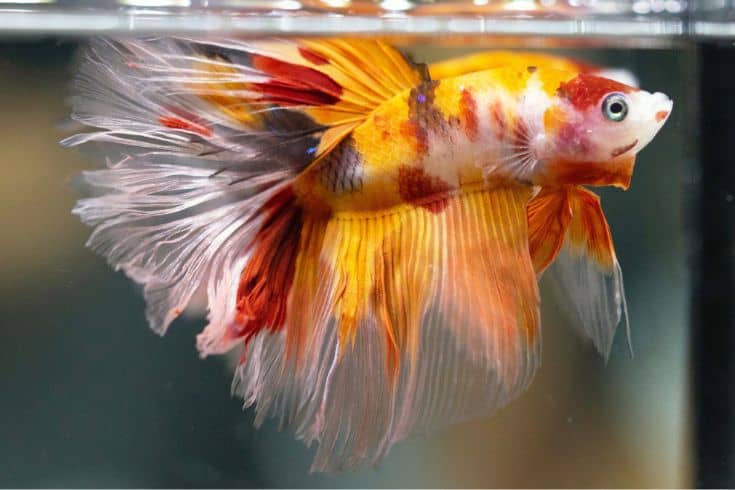
Most koi bettas have a lifespan of 2-3 years, although some have been known to live for up to 5 years with proper care. As with any other pet, the key to a long and healthy life is providing them with the best possible care.
When it comes to temperament, koi bettas are relatively peaceful fish that get along well with other similarly-sized community fish. However, it’s important to remember that they can reveal themselves as territorial fish when they feel threatened or invade their space. For this reason, it’s best to keep them with other peaceful fish that won’t cause them any stress.
Koi bettas are also known to be quite active, social, and alert fish. They enjoy being in the company of other fish and will often swim in groups if given the opportunity. These fish are also very curious by nature and love to explore their surroundings, so it’s important to provide them with plenty of hiding places and swimming space.
Compatibility/Mates
We’ve touched briefly on the types of tank mates that are compatible with koi bettas, but let’s go into a bit more detail.
As we mentioned, these fish are naturally peaceful and do well in community tanks with other similarly-sized fish. It is also possible to house multiple koi bettas together in an all-female koi betta sorority tank.
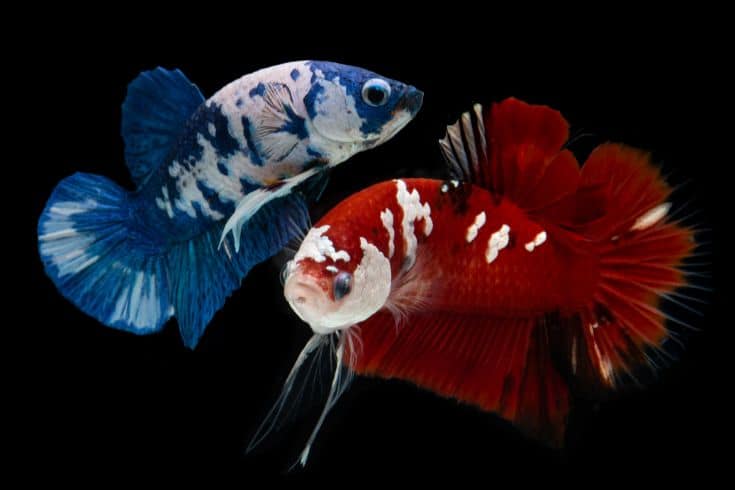
These setups feature 4 or more female koi bettas that live together peacefully. While these tanks can be a bit more challenging to set up and maintain, they’re a great way to enjoy the beauty of these fish without having to worry about breeding.
It’s important to remember that koi bettas are still territorial fish, so providing them with plenty of hiding places and swimming space is important. If you’re planning on keeping multiple koi bettas together, we recommend a tank size of 20 gallons or more.
What Do Koi Bettas Eat?
Much like other betta fish, koi bettas are omnivores that enjoy a varied diet. A good quality betta pellet or flake food should form the basis of their diet, but they will also enjoy live or frozen foods such as brine shrimp, bloodworms, daphnia, and insect larvae.
Although pet stores can be a great place to buy betta food, it’s important to read the ingredients list before making a purchase. Many of these products contain fillers and artificial additives that can be detrimental to your fish’s health. Instead, look for high-quality food such as whole fish meal, shrimp meal, and vegetable matter.
Some hobbyists believe that supplements can lead to brighter colors and healthier fish. While there’s no scientific evidence to support this claim, we believe that adding some variety to your koi betta’s diet can’t hurt. Just be sure to do your research and only feed them supplements that are safe for bettas.
Last but not least, plant matter should also be included in their diet. Koi bettas love to nibble on live plants, so adding a few to their tank is a great way to keep them healthy and happy. Not to mention, plants help to oxygenate the water and provide your fish with a place to hide if they’re feeling stressed.
Feeding Frequency – How Do You Prevent Overfeeding?
It’s important to feed your koi betta 2-3 times per day, but only give them as much food as they can eat in 1minutes. This may not seem like a lot, but bettas are known to be voracious eaters and will quickly overeat if given the opportunity.
Overfeeding is one of the most common problems faced by betta owners, and it can lead to a number of health problems such as bloating, intestinal blockages, and swim bladder disease. Not to mention, uneaten food can pollute the water and lead to harmful algae growth.
To avoid overfeeding, we recommend using a small food scoop or syringe to portion out their meals. This will help you to better control how much food they’re eating and prevent them from overeating.
If you’re unsure how much to feed your koi betta, err on caution and give them a little less than you think they need. It’s always better to underfeed your fish than to overfeed them.
Habitat Requirements
Having covered diet and compatibility, let’s move on to habitat requirements. In this section, we’ll take a look at what you need to create a comfortable and safe environment for your koi betta.
Water Conditions
Koi bettas are native to the slow-moving rivers and streams of Southeast Asia, so they’re accustomed to warmer water with a neutral pH. While it isn’t necessary to replicate Southeast Asian conditions exactly, you’ll need to provide them with warm water (78-82 degrees Fahrenheit), clean, and well-filtered.
Additionally, the water parameters in your koi betta’s tank should be as stable as possible. Though bettas thrive in a wide range of water conditions, large fluctuations in water temperatures and pH can cause stress and lead to illness. Therefore, it is important to test the water regularly and take steps to maintain optimal water conditions.
The final component of a koi betta’s habitat is a good filter. Though you are unlikely to spot a water filter in a pet shop betta setup, these devices are vital for the health of your fish. A good filter will help to keep the water clean and free of harmful ammonia and nitrites. Water quality is especially important in larger tanks that are home to multiple fish.
Tank Maintenance
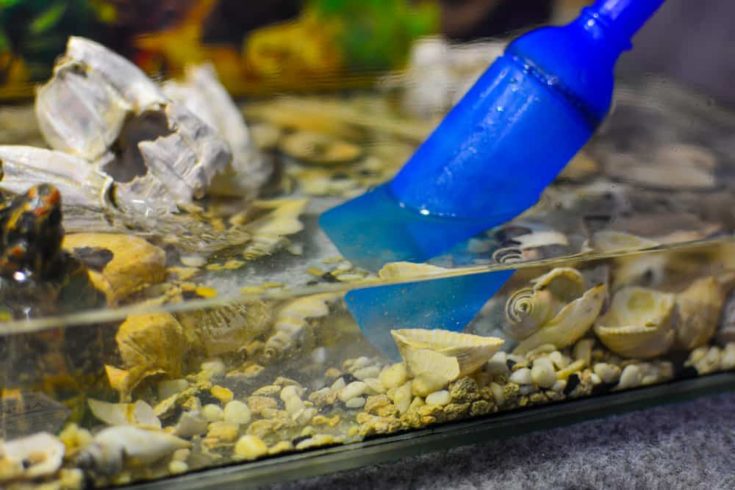
Now that we’ve gotten the basics out of the way, it’s time to move on to tank maintenance. Caring for your koi betta’s habitat is essential to minimize the risk of infections and disease. Something like a contagious bacterial infection can wreak havoc on an entire community tank, so it’s important to take preventive measures.
One of the most common myths about bettas is that they can thrive in all types of subpar tank conditions. This myth stems from the fact that wild bettas live in the murky waters commonly associated with rice paddies.
However, it is important to note that rice paddies don’t necessarily present poor conditions for fish. In fact, the roots of the rice plants provide a natural filtration system, thus keeping the water clean. Additionally, the mud at the bottom of rice paddies is rich in nutrients, which helps to support a healthy ecosystem.
In short, don’t believe everything you read about bettas! While it’s true that they are hardy fish, they still need clean, well-maintained tanks to thrive.
Plants and Decorations
As we mentioned earlier, koi bettas love to nibble on live plants. In fact, many hobbyists use plants to supplement their koi betta’s diet. Not only do plants provide a source of food, but they also help to oxygenate the water and provide your fish with a place to hide if they’re feeling stressed.
When choosing plants for your koi betta’s tank, it is important to avoid those that are known to be toxic to fish. Some common examples include azaleas, oleanders, and rhododendrons. Additionally, be sure to research the plants you’re considering to ensure they are compatible with bettas.
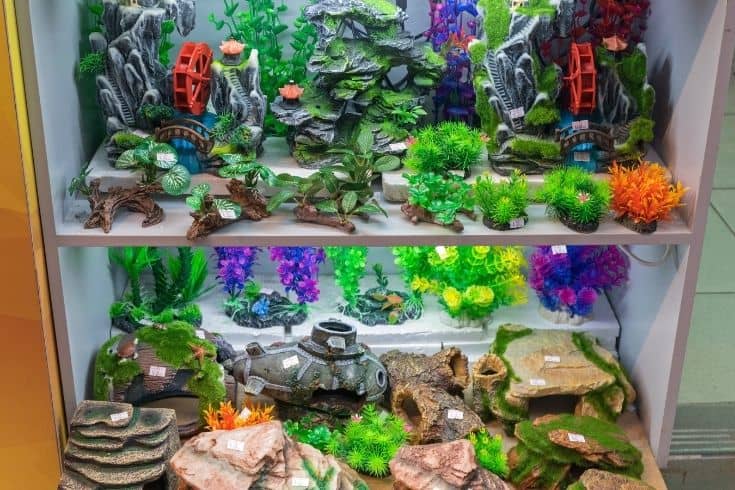
If you’re looking for an alternative to live plants, artificial plants can also be used to create a beautiful and natural-looking environment for your koi betta. These plants are often made from silk or plastic and come in a wide variety of colors and styles. Just remember to steer clear of plants with jagged edges that may snag your fish’s fins.
As for decorations, the sky is the limit! Koi bettas are relatively small fish, so they don’t need a lot of space to swim. This means you can get creative with your tank setup and choose decorations that suit your personal style. Caves, driftwood, and rocks are all popular choices, but feel free to get creative. Just be sure any decorations you use are safe for fish!
Common Health Issues
Now that we’ve covered the basics of koi betta care, let’s take a moment to discuss some common health issues. By familiarizing yourself with these conditions, you’ll be better equipped to identify them early on and take steps to prevent them.
Stress
The most common health issue affecting koi bettas is stress. As we mentioned earlier, bettas are highly sensitive to environmental changes. When they become stressed, their immune systems are weakened, making them susceptible to illness.
Many different factors can cause stress in koi bettas. Some of the most common include poor water quality, inadequate tank size, and a lack of hiding places. It is important to create a stress-free environment for your koi betta in order to minimize the risk of illness.
Bacterial Infections

Bacterial infections are another common health issue in koi bettas. These infections often result from poor water quality and can cause various symptoms, including lethargic behavior, loss of appetite, and cloudy eyes. If left untreated, bacterial infections can be fatal.
Maintaining a clean and well-filtered tank is the best way to prevent bacterial infections. Be sure to perform regular water changes and monitor your koi betta’s food and waste to ensure they are eating and defecating properly.
Fungal Infections
Fungal infections are similar to bacterial infections, but fungi rather than bacteria cause them. The most common symptom of a fungal infection is white patches on the skin or fins. Though they may not necessarily be deadly, fungal infections can be extremely uncomfortable for your koi betta and should be treated as soon as possible.
Fungal infections occur when typically harmless fungi present in the environment can take hold in a fish’s weakened body. Poor water quality is often to blame, so be sure to maintain a clean tank and keep an eye out for early signs of illness.
These are some of the most common health issues affecting koi bettas, but many others exist. It is important to consult a veterinarian if you suspect your koi betta is sick, as early diagnosis and treatment are essential for a successful outcome.
Breeding Your Koi Betta
The beautiful colors and patterns of koi bettas come from generations of selective breeding by specialized betta breeders. While you may not be interested in breeding koi bettas yourself, it is still fascinating to learn about the mating process.
The first step in breeding koi bettas is to select a breeding pair consisting of one male and one female. You can identify sexually mature fish by their coloration and size; males typically exhibit brighter colors, while female bettas may have an egg spot or a white lump featured prominently close to their vent.
Once you have selected a breeding pair, you should place them in a breeding tank where the male can build a bubble nest. After that, the female betta will lay her eggs, and the male will retrieve them and place them in the bubble nest.
After spawning, the female koi bettas should be removed from the breeding tank to prevent them from eating the eggs. The male koi betta will remain in the breeding tank to care for the eggs until they hatch, which usually takes place after 3 days.
Koi Betta Fish Tank Requirements
Ready to add a koi betta to your home? Before you do, you’ll need to ensure you have a suitable tank set up. This section will cover everything you need to know about koi betta tank requirements.
Tank Size
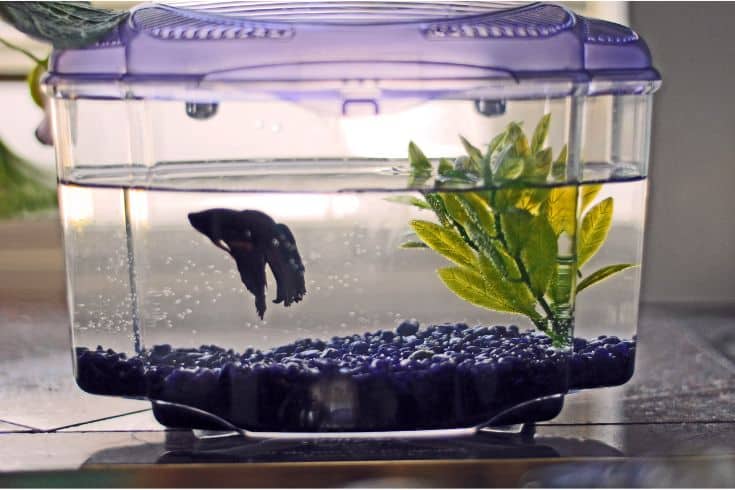
Is a larger tank necessarily better? Though the general rule of thumb is that bigger is always better when it comes to fish tanks, this isn’t necessarily the case with koi bettas. Larger aquariums require more expensive equipment and are more difficult to maintain, so it’s important to find a balance between tank size and your level of experience.
That being said, you should also steer clear of desktop tanks that scarcely hold more than a gallon of water. Koi bettas are active swimmers and need plenty of space to move around, so a small tank is likely to cause your fish stress.
As a general rule, we recommend a minimum tank size of 5 gallons for koi bettas. These are hardy fish, so they can do well in larger tanks, but 5 gallons should be sufficient for most beginner hobbyists.
Filtration Requirements
Koi bettas are not particularly messy fish but produce a fair amount of waste. For this reason, we recommend using a filter rated for at least twice the volume of your tank. Sponge filter systems are typically a good option for koi betta tanks because they are beginner-friendly and gentle on fry (baby fish).
Canister and hang-on-back filters can also be used, but make sure you opt for an adjustable filter so that you can control the flow rate. Koi bettas are not strong swimmers and may be pushed around or even injured by a filter with too strong of a flow. A gentle filter flow is typically all that is necessary to keep your koi betta tank clean.
What Else Do You Need For A Betta Tank? Product Recommendations
Now that you know the basics of what you need to set up a koi betta tank, you may be wondering what other supplies are necessary. In addition to a filter, there are a few other key items you’ll need for your koi betta tank. We’ve compiled a list of our top product recommendations to get you started:
- Quality fish food: We recommend New Life Spectrum pellets because they are high in protein and low in fillers.
- Water conditioner: This is essential for removing chlorine and other harmful chemicals from your tap water. We recommend Seachem Prime.
- Aquarium gravel: This is necessary for planting and anchoring your plants. We recommend Fluval Aquatic Plant Substrate.
- Tank heater: Koi bettas are tropical fish and need warm water to thrive. We recommend the Tetra submersible aquarium heater.
- Live plants: Live plants are not only beautiful, but they also provide your koi betta with oxygen and hiding places. We recommend Java fern, hornwort, and anubias.
Koi Betta Tank Setup
Have you gathered all the necessary supplies? It’s time to set up your koi betta tank! Follow the steps below to get started:
1. Choose a location for your tank. Finding a place that is out of direct sunlight and away from any drafts is important.
2. Rinse your gravel and plants with dechlorinated water. This will remove any harmful chemicals that could harm your fish.
3. Add 2-3 inches of gravel to the bottom of your tank.
4. Fill your tank with dechlorinated water and add your plants.
5. Install your filter and heater.
6. Cycle your tank for 2-4 weeks before adding fish. This will allow time for the beneficial bacteria in your aquarium to build up.
7. Add your koi betta to the tank and enjoy!
The Takeaway
Koi betta fish are beautiful and popular fish that make great pets. In this ultimate care guide, we’ve taught you everything you need to know about koi betta fish, from their diet and habitat needs to their tank requirements.
We hope you’ve found this guide helpful and that it gives you the confidence you need to add a koi betta to your home. Thanks for reading!
